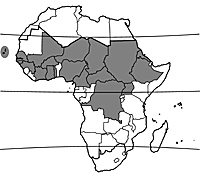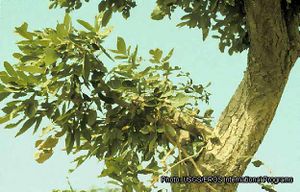Philenoptera laxiflora (PROTA)
Introduction |
| General importance | |
| Geographic coverage Africa | |
| Geographic coverage World | |
| Fruit | |
| Vegetable | |
| Spice / condiment | |
| Dye / tannin | |
| Medicinal | |
| Timber | |
| Fuel | |
| Ornamental | |
| Forage / feed | |
| Food security | |
Philenoptera laxiflora (Guill. & Perr.) Roberty
- Protologue: Bull. Inst. Franç. Afr. Noire, Sér. A., 16(2): 354 (1954).
- Family: Papilionaceae (Leguminosae - Papilionoideae, Fabaceae)
- Chromosome number: 2n = 22
Synonyms
- Lonchocarpus laxiflorus Guill. & Perr. (1832),
- Philenoptera schimperi Hochst. ex A.Rich. (1847).
Vernacular names
- Gambian indigo (En).
- Savonnette (Fr).
Origin and geographic distribution
Philenoptera laxiflora is widely distributed in tropical Africa from Cape Verde and Senegal to Eritrea and DR Congo.
Uses
In West Africa, particularly in Senegal, Gambia and northern Nigeria, but also in the Kordofan province of western Sudan and in the Kasango region of eastern DR Congo, the leaves were and may still be used as source of an indigo dye in the same manner as those of gara (Philenoptera cyanescens (Schumach. & Thonn.) Roberty) and the same range of blue colours can be obtained as with gara and Natal indigo (Indigofera arrecta Hochst. ex A.Rich.). In Gambia the dye was much used to make the famous ‘bara siti’ cloth in which decorative patterns are made by crumpling and binding parts of the tissue during the dye process. This tie and dye technique originates from the Soninké people in Senegal. In Senegal and Guinea, Tenda people use the bark in a condiment mixture. In the Central African Republic young leaves are eaten as a cooked vegetable and Gbaya people eat the flowers and fresh young fruits. The fruit is also eaten cooked with potherbs and sesame paste. After boiling, the fruits can be dried and stored for later use. The leaves are browsed or used as fodder for goats. In many places the tree is used for pole timber and as a source for fuelwood and charcoal. In Ghana, Senegal and Sudan the roots and bark are used as a tonic and to treat jaundice. In the Central African Republic a decoction of young leaves is taken against liver troubles. In Ethiopia the root is used externally against stomach-ache. In Nigeria and Sudan the leaves are applied as a poultice on ulcers and a decoction of the bark is used against intestinal problems of horses. In Nigeria leaves and bark are used as an insecticide and as an external anti-parasitic for scabies and ringworm. With its delicately scented blue or pinkish flowers, crowded in panicles all over the crown, Philenoptera laxiflora is a potential ornamental tree.
Production and international trade
Dyers in Gambia collect leaves from wild trees but also import Philenoptera laxiflora leaf balls from Sierra Leone and Nigeria. Production and trade statistics are not available.
Properties
In Sudan (Kordofan) the dye obtained from Philenoptera laxiflora is considered of lower quality than the dye from Philenoptera cyanescens. The wood is pale yellow, hard and heavy. Research on the chemical composition of Philenoptera laxiflora is still needed, especially concerning the alleged presence of indigo precursors in the leaves. The isoflavanes lonchocarpane and laxiflorane and the pterocarpans philopterane and its 9-O-methyl derivative were isolated from the root bark.
Description
- Deciduous small tree up to 12 m tall; bark fibrous, grey or brownish outside, becoming rough and flaking, slash yellow-white exuding a red resin.
- Leaves alternate, up to 45 cm long, imparipinnately compound with 2–3 pairs of opposite leaflets; rachis of mature leaves 3–6 cm prolonged beyond upper pair of leaflets; stipules and stipels linear, up to 2 mm long, caducous; leaflets elliptical, 5–18 cm × 2–6 cm, terminal leaflet largest, slightly leathery, thinly hairy beneath, pinnately veined.
- Inflorescence a terminal or axillary panicle up to 60 cm long, at first erect but ultimately pendulous, strongly but shortly branched.
- Flowers bisexual, papilionaceous, up to 1.5 cm long; calyx campanulate, with short teeth; corolla pinkish-mauve to deep lilac with a median white or yellow patch inside on standard; stamens 10, united into a tube; ovary superior, shortly stalked, 1-celled, style curved, stigma minute.
- Fruit a narrowly elliptical to linear-oblong, flattened pod, 6–14 cm × 1–2 cm, narrowed at both ends, slightly sinuate between the 1–4 seeds, papery, shortly hairy and reddish green, becoming glabrous and pale brown at maturity.
- Seeds oblong to kidney-shaped.
Other botanical information
Philenoptera belongs to the tribe Millettieae and comprises 12 species confined to Africa and Madagascar. Formerly these species were grouped in Lonchocarpus, a genus now considered to be confined to tropical America. When flowers and fruits are absent Philenoptera laxiflora can easily be confused with Stereospermum kunthianum Cham. (Bignoniaceae) in which however the leaf-rachis does not extend beyond the upper pair of leaflets.
Growth and development
Flowering precedes or is simultaneous with the appearance of new leaves at the beginning of the rainy season.
Ecology
Philenoptera laxiflora occurs in savanna or deciduous woodland, from sea-level up to about 2100 m altitude.
Harvesting
Leaves can be collected whenever available in the rainy season.
Handling after harvest
Leaves are bruised to a pulp and made up into balls 10–12 cm in diameter. These balls are dried in the sun and sold on markets. To dye cloth into various shades of blue, the dye-vat is prepared by soaking crushed balls in hot water, the number depending on the desired intensity of the blue colour. The necessary alkalinity is obtained by adding lye from wood-ash. The solution is left to ferment for 6–8 days usually and the dye bath is then ready for the cloth to be steeped into it. In the Kasongo region of DR Congo, young leaves of Morinda lucida Benth. are put into the dye-vat of Philenoptera laxiflora leaves and the resulting greenish dye is used to dye mats.
Genetic resources
Philenoptera laxiflora is widespread and not in danger of genetic erosion. In regions where it is much used and not cultivated it can become rare.
Prospects
As one of the sources of natural dyes for the important ‘bara siti’ cloth in the cottage industry in Gambia and as indigo source in various other countries Philenoptera laxiflora is only likely to retain some importance in regions where no better indigo sources of plant origin are available. Research on optimum cultivation methods for dye production and ornamental planting is recommended.
Major references
- Arbonnier, M., 2004. Trees, shrubs and lianas of West African dry zones. CIRAD, Margraf Publishers Gmbh, MNHN, Paris, France. 573 pp.
- Burkill, H.M., 1995. The useful plants of West Tropical Africa. 2nd Edition. Volume 3, Families J–L. Royal Botanic Gardens, Kew, Richmond, United Kingdom. 857 pp.
- Cardon, D., 2003. Le monde des teintures naturelles. Belin, Paris, France. 586 pp.
- Gillett, J.B., Polhill, R.M., Verdcourt, B., Schubert, B.G., Milne-Redhead, E., & Brummitt, R.K., 1971. Leguminosae (Parts 3–4), subfamily Papilionoideae (1–2). In: Milne-Redhead, E. & Polhill, R.M. (Editors). Flora of Tropical East Africa. Crown Agents for Oversea Governments and Administrations, London, United Kingdom. 1108 pp.
- Nacro, M. & Millogo-Rasolodimbi, J., 1993. Plantes tinctoriales et plantes à tanins du Burkina Faso. Editions ScientifikA, Amiens, France. 152 pp.
- Schrire, B.D., 2000. A synopsis of the genus Philenoptera (Leguminosae - Millettieae) from Africa and Madagascar. Kew Bulletin 55: 81–94.
Other references
- Baumer, M.C., 1975. Catalogue des plantes utiles du Kordofan (République du Soudan) particulièrement du point de vue pastoral. Journal d’Agriculture Tropicale et de Botanique Appliquée 22: 105.
- Berhaut, J., 1976. Flore illustrée du Sénégal. Dicotylédones. Volume 5. Légumineuses Papilionacées. Gouvernement du Sénégal, Ministère du Développement Rural et de l’Hydraulique, Direction des Eaux et Forêts, Dakar, Senegal. 658 pp.
- Hepper, F.N., 1958. Papilionaceae. In: Keay, R.W.J. (Editor). Flora of West Tropical Africa. Volume 1, part 2. 2nd Edition. Crown Agents for Oversea Governments and Administrations, London, United Kingdom. pp. 505–587.
- Irvine, F.R., 1961. Woody plants of Ghana, with special reference to their uses. Oxford University Press, London, United Kingdom. 868 pp.
- Pelter, A. & Amenechi, P.I., 1969. Isoflavonoid and pterocarpinoid extractives of Lonchocarpus laxiflorus. Journal of the Chemical Society 6: 887–896.
- Staner, P., 1936. Plantes congolaises à propriétés tinctoriales. In: Ceuterick, F. (Editor). Agricultura. Louvain, Belgium. 39 pp.
- Vergiat, A.M., 1970. Plantes magiques et médicinales des féticheurs de l’Oubangui (Région de Bangui). Journal d’Agriculture Tropicale et de Botanique Appliquée 17: 295–339.
Sources of illustration
- Thulin, M., 1989. Fabaceae (Leguminosae). In: Hedberg, I. & Edwards, S. (Editors). Flora of Ethiopia. Volume 3. Pittosporaceae to Araliaceae. The National Herbarium, Addis Ababa University, Addis Ababa, Ethiopia and Department of Systematic Botany, Uppsala University, Uppsala, Sweden. pp. 49–251.
Author(s)
- D. Cardon, CNRS, CIHAM-UMR 5648, 18, quai Claude-Bernard, 69365 Lyon, Cedex 07, France
- P.C.M. Jansen, PROTA Network Office Europe, Wageningen University, P.O. Box 341, 6700 AH Wageningen, Netherlands
Correct citation of this article
Cardon, D. & Jansen, P.C.M., 2005. Philenoptera laxiflora (Guill. & Perr.) Roberty. In: Jansen, P.C.M. & Cardon, D. (Editors). PROTA (Plant Resources of Tropical Africa / Ressources végétales de l’Afrique tropicale), Wageningen, Netherlands. Accessed 6 March 2025.
- See the Prota4U database.



